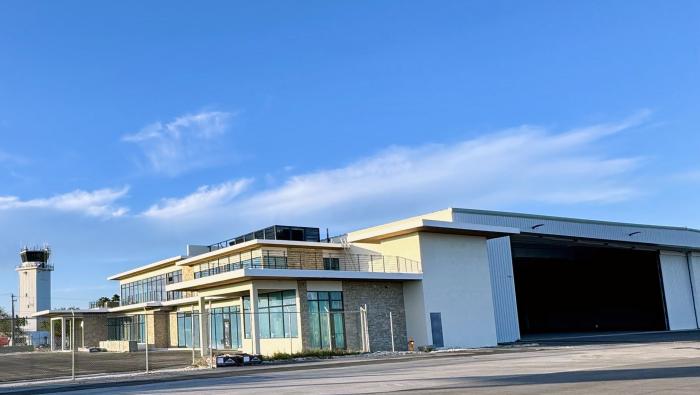
Florida's Miami Executive Airport (KTMB) will unveil a new FBO terminal with next month's opening of the International Flight Center (IFC) facility, part of the redevelopment of the company’s main leasehold. IFC—one of four service providers on the field—occupies 15-plus acres at KTMB, including more than 12 acres of ramp.
Located on the southwest side of the airport adjacent to the U.S. Customs and Border Protection office, the 10,500-sq-ft building quadruples in size the terminal the company had used since 1986. The older terminal and adjoining 12,400-sq-ft hangar were demolished in the third quarter."
The soon-to-be-completed two-story terminal features a passenger lounge, pilot lounge with full bed/bathroom snooze rooms, refreshment bar, business center, 10-seat A/V-equipped conference room, upstairs observation deck, and a café.
Earlier this year, the Avfuel-branded FBO debuted a new 84,000-sq-ft hangar complex, equipped with foam-free fire suppression and capable of accommodating the latest ultra-long-range business jets. That brought the complex to more than 120,000 sq ft of aircraft shelter.
“We couldn’t be more excited to start a new year in a new, luxury facility,” said IFC president Wilfredo Valle. “Every detail of this development has been meticulously planned for the ultimate private flying experience—for pilots and passengers alike. Now, our accommodations will match the industry-leading care our customers have come to know and trust out of IFC.”
|
NASA has collected unmanned aircraft systems (UAS) safety reports in its Aviation Safety Reporting System (ASRS) since August 2021. Operators of unmanned and manned aircraft file reports on a range of issues such as close calls, hazards, airspace violations, mechanical failures, and other safety-related events.
The first NASA UAS ASRS database report set was published in July. Absent from this dataset are any ridiculous claims of nefarious drone operations by “bad actors” throughout New Jersey and other East Coast states. This report provides some real insight into safety issues affecting operators of manned and unmanned aircraft in the U.S.
Since this dataset includes 50 reports and each report is voluntarily submitted, it’s difficult to infer the prevalence of a specific problem in the National Airspace System. However, there are two main categories of submissions to NASA by operators of unmanned and manned aircraft in the U.S.: noncompliance with CFRs (50%) and near-midair collisions (42%). A third category relates to mechanical or link failures, accounting for only 8% of events.
Over half of noncompliance events are caused by Part 107 pilots flying a UAS into controlled airspace or TFR area without authorization. Others exceed airspace/altitude or weather restrictions. ATC often reports military UAS operators not complying with a clearance. As for near-midair collisions (NMAC), pilots who fly for hire reported 13 events, general aviation pilots reported six, and two Part 107 operators reported NMACs.
|
The issue of mental health in aviation reached a critical turning point in 2024, with government leaders and stakeholders across the industry coming together to address long-standing barriers that have discouraged pilots, air traffic controllers, and other aviation professionals from seeking necessary care. As such, the past year has seen a series of updates, initiatives, and other collaborative efforts focused on easing the path for pilots and air traffic controllers in need of help.
A much-anticipated Mental Health & Aviation Medical Clearances Aviation Rulemaking Committee (ARC) report was published in April heralding significant changes in the industry's approach to mental health.
Formed in December 2023, the FAA/industry ARC was tasked with identifying and addressing the barriers preventing aviation professionals from disclosing mental health concerns. The committee’s report laid out 24 specific recommendations to foster better mental health support for pilots and controllers.
The FAA responded by updating its Guide for Aviation Medical Examiners (AME Guide). Pilots with a history or diagnosis of anxiety, depression, or related conditions now have clearer, less restrictive guidelines for obtaining medical clearance, provided they meet certain criteria.
The FAA has also made strides in reducing the time it takes to process medical certifications for pilots with mental health conditions. Historically, the certification process could take years. In 2024, the FAA introduced a new AME decision tool to streamline this process.
|
Switzerland-based QCM Design has developed an EASA supplemental type certificate (STC) to replace Halon fire extinguishers in Dassault’s Falcon 7X. The change helps Falcon 7X operators meet EASA’s Regulation No 1005/2009, “which stipulates that the use of portable extinguishers which contain Halon on aircraft is no longer permitted after 2025,” according to the company.
The new extinguishers installed under the STC use European Union- and EASA-approved Halotron BrX fire-extinguishing agent, made by American Pacific of Cedar City, Utah. BrX is more suited to aviation applications because it has a “lower weight equivalence to Halon 1211,” according to American Pacific, due to its chain-breaking effect.
BrX includes bromine, a “chain-breaker atom which interferes with the chemical transitions necessary to support combustion.” The substance doesn’t leave any residue after application.
If the 7X’s configuration includes the standard two 5B:C and one 2A/10B:C extinguishers, the STC installation takes one day. If there are deviations, QCM Design can assess the best way to manage the changes. The company is also developing STCs for the Airbus A318 and A319 and expects approval by early 2025.
|
Regulators in Argentina, the European Union, India, and Japan have approved the improved empennage on all models of the Robinson Helicopter family, including the R22, R44, and R66. The new empennage is standard on new Robinson models (R44 and R66 in Argentina; R44 Raven I and R66 in India; and R22 and R44 in Japan) and includes the symmetrical horizontal stabilizer and tailcone.
According to Robinson Helicopter, the symmetrical horizontal stabilizer improves roll stability, “particularly during high-speed flights, [and] it contributes to a smoother and safer flight experience. Additionally, the symmetrical stabilizer helps reduce the right-rolling tendency when the aircraft is operated outside of the approved flight envelope.”
The empennage is available as a retrofit, and following FAA approval for the R66 in 2023 and R44 and R22 in 2024, Robinson Helicopter has delivered about 250 new helicopters with the new empennage and nearly 700 retrofit kits. Through the end of December 2025, the company is offering a discounted rate of $3,600 for the retrofit kit.
The Torrance, California-based manufacturer has also received FAA approval to extend the service life for R22 and R44 main rotor blades from 12 to 15 years.
In 2025, three new training courses will be available: R66 Transition; Avionics and Autopilot Familiarization; and Post-Maintenance Procedure. The latter will help pilots learn how “to conduct post-maintenance flights safely and effectively.”
|

Photo of the Week
Watching with anticipation. AIN contributing photographer David McIntosh captured onlookers waiting for the latest display at the 2024 edition of the Singapore Airshow. Singapore’s Changi Exhibition Centre at Changi Airport hosted some 60,000 trade attendees during the 2024 event. The site of the major biannual international airshow since 2008, Changi is now prepping for its next and newest tradeshow event, the Business Aviation Asia Forum & Expo (BAAFEx) to be held March 4-6. The business aviation tradeshow is expected to become biannual, alternating years with the larger and broader aerospace-oriented airshow. Thanks for sharing, David!
Keep them coming. If you’d like to submit an entry for Photo of the Week, email a high-resolution horizontal image (at least 2000 x 1200 pixels), along with your name, contact information, social media names, and info about it (including brief description, location, etc.) to photos@ainonline.com. Tail numbers can be removed upon request. Those submitting photos give AIN implied consent to publish them in its publications and social media channels.
|
AINalerts News Tips/Feedback:
News tips may be sent anonymously, but feedback must
include name and contact info (we will withhold name on request). We reserve the
right to edit correspondence for length, clarity, and grammar. Send feedback or
news tips to AINalerts editor Chad Trautvetter.
|
AINalerts is a publication of AIN Media Group, 214 Franklin Avenue, Midland Park, New Jersey. Copyright 2024. All rights reserved.
Reproduction in whole or in part without permission is strictly prohibited.
|
|













